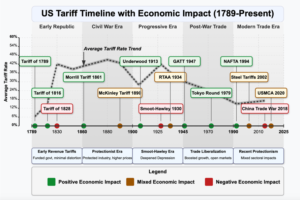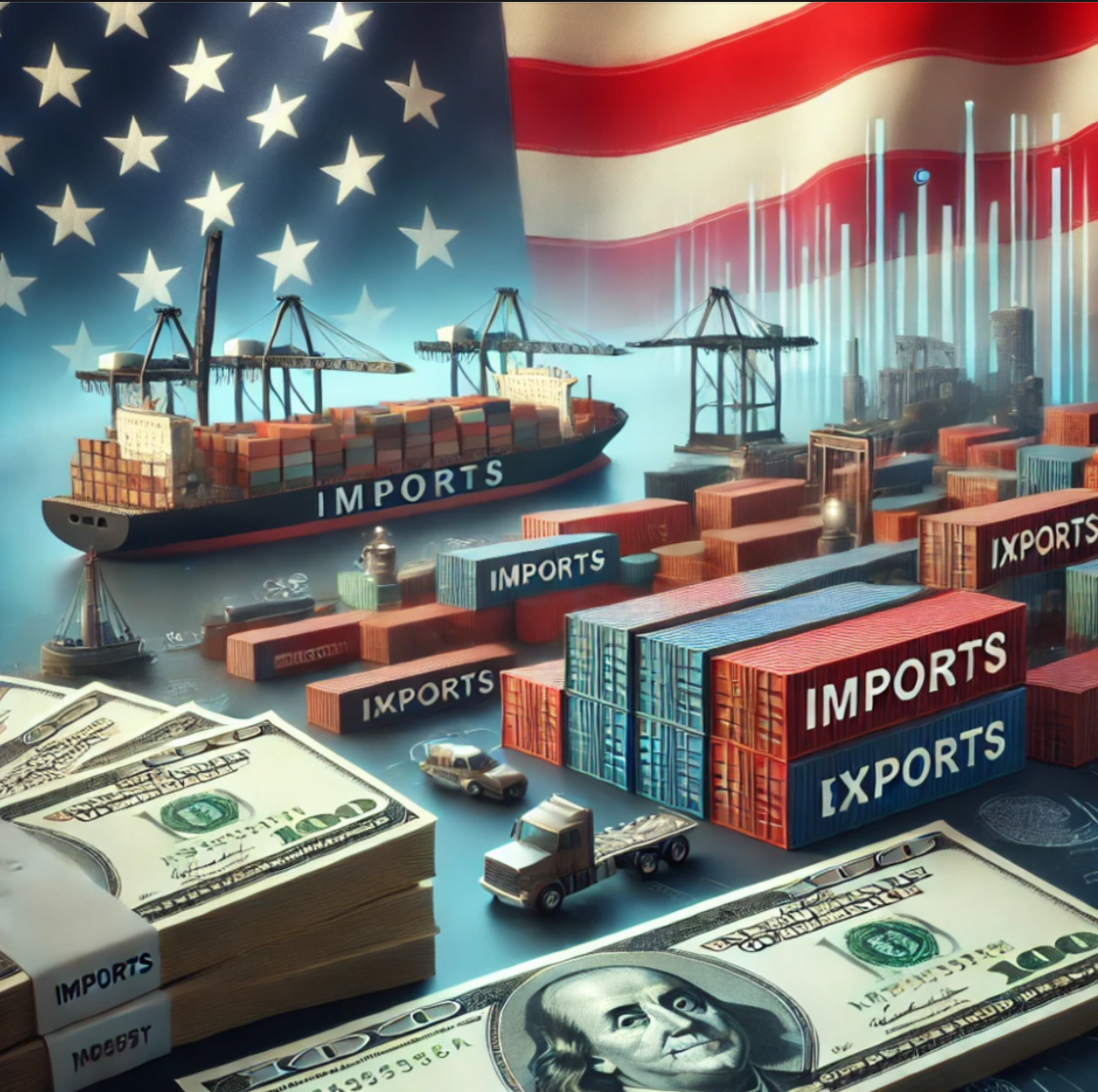On an otherwise insignificant February morning in 1930, President Herbert Hoover signed the Smoot-Hawley Tariff Act, a piece of legislation meant to protect American industries. But instead of securing economic stability, those pen strokes accelerate the Great Depression. Within months, global trade collapsed, U.S. exports plummeted, and once-thriving businesses shuttered their doors.
This wasn’t the first time — or the last — that American trade policy swung between protectionism and free trade. For over two centuries, the United States has wrestled with a recurring question: Should we shield our industries with tariffs or open our markets to global competition?
From Alexander Hamilton’s early push to protect fledgling American manufacturers to the recent debates over reshoring critical supply chains and imposing tariffs on strategic industries, this pendulum swing has shaped economies, influenced elections, and transformed industries.
Today, as policymakers confront issues like trade imbalances, technological competition, and climate-related tariffs, history offers more than just context—it provides crucial lessons about the real-world consequences of economic isolation and global integration.
This piece explores five pivotal eras in U.S. tariff history—not just as economic events, but as moments that reveal how America defines prosperity, security, and its place in the world.

Early Republic (1789-1860): Foundations of Trade Policy
In 1791, Alexander Hamilton’s “Report on Manufactures” outlined a vision for American economic development requiring protective tariffs for infant industries. This contradicted the free-trade principles in Adam Smith’s “The Wealth of Nations,” establishing a tension between revolutionary ideals and economic practice.
The Tariff of 1789, signed by Washington, established modest duties averaging 8-10%, primarily to generate revenue for the federal government.
After the War of 1812, ideological protectionism emerged. The Tariff of 1816 marked America’s first genuinely protective trade legislation, doubling rates to approximately 20% on key manufactured goods. New England manufacturers celebrated; Southern cotton planters suffered.
By 1828, the “Tariff of Abominations” imposed duties reaching 50% on certain imports, favoring Northern manufacturing interests over Southern agricultural concerns. Cotton exports—over half of all American exports—fell by nearly 30%. In response, John C. Calhoun developed his nullification doctrine, foreshadowing the Civil War.
Civil War Era (1861-1900): Peak Protectionism
The Morrill Tariff of 1861, enacted as Southern states seceded, generated revenue for the war effort and rewarded Northern industrial interests that supported Lincoln. With rates climbing to 40%, the legislation cemented the North’s protectionist victory just as Fort Sumter’s cannons signaled the military phase of the conflict.
Post-Civil War America transformed from an agricultural republic into an industrial power behind increasingly high tariff barriers. The McKinley Tariff of 1890 pushed duties to nearly 50%, allowing domestic industries to flourish while consumers paid approximately 4.5% more for many goods.
Factory whistles called ever more workers in Pennsylvania steel towns and Massachusetts textile cities. In Lowell, Massachusetts, mill workers found steady employment but struggled to afford basic household goods whose prices had risen by nearly 20%. Meanwhile in Iowa, farmers saw their livelihoods threatened as corn exports dropped by nearly a third in just two years due to retaliatory tariffs. Protection for some meant hardship for others—a tension that continues to define trade debates today.
Progressive Era (1901-1945): Reform and Reaction
The Progressive Era brought reconsideration of tariff policy. In 1913, Woodrow Wilson’s Underwood Tariff substantially reduced import duties. “The object of tariff duties henceforth laid must be effective competition,” Wilson declared, viewing competition—not protection—as the engine of industrial advancement.
Consumer prices fell by approximately 5% on imports, and American manufacturers modernized production methods. The federal income tax replaced tariffs as a primary government funding source.
This progressive interlude was brief. The 1920s Republican resurgence revived protectionism, culminating in the Smoot-Hawley Tariff of 1930. Implemented after the stock market crash, it raised duties when global economic cooperation was most needed. U.S. imports collapsed from $4.4 billion in 1929 to $1.3 billion in 1932, while exports fell from $5.4 billion to $1.6 billion. The tariff contributed an estimated additional 2% decline in global GDP during the Depression.
Roosevelt’s election in 1932 marked another shift. The Reciprocal Trade Agreements Act of 1934 authorized the president to negotiate tariff reductions without congressional approval for each treaty. By 1939, the United States had agreements with 21 countries, covering 60% of American imports and reducing tariff rates by an average of 44%.
Post-War Trade (1945-1980s): Global Leadership
The General Agreement on Tariffs and Trade (GATT), established in 1947, institutionalized America’s commitment to trade liberalization. Average U.S. tariff rates fell below 15% as part of economic internationalism. Global trade expanded from $53 billion in 1948 to $157 billion by 1963, lifting living standards across the democratic world.
The Tokyo Round (1973-1979) reduced industrial tariffs by an average of 33% and addressed non-tariff barriers. This multilateral approach represented the peak of American leadership in trade liberalization, using commerce as both economic and geopolitical strategy against Soviet influence.
Average tariff rates fell below 10% on most industrial goods. American consumers gained access to an unprecedented variety of foreign goods, from German automobiles to Japanese electronics, at increasingly affordable prices.
Modern Trade Era (1990s-Present): Globalization and Selective Protectionism
NAFTA, implemented in 1994, eliminated most tariffs between the United States, Canada, and Mexico. Trade between the U.S. and Mexico quadrupled from $81 billion in 1993 to $346 billion by 2015. Yet an estimated 682,900 U.S. jobs were lost or displaced between 1994 and 2010, concentrated in Midwest manufacturing communities.
The Bush administration’s steel tariffs of 2002 (up to 30% on certain products) demonstrated the appeal of selective protectionism even during trade liberalization. These tariffs were withdrawn in 2003 after being ruled illegal by the WTO.
The Trump administration’s China trade war (2018-2020) represented both a return to protectionism and something novel: weaponizing tariffs for geopolitical competition rather than economic policy. Tariffs on Chinese goods surged from 3% to over 20%, while American farmers faced retaliatory measures requiring $28 billion in government subsidies. Moody’s Analytics estimated the trade war cost approximately 300,000 jobs and 0.3% of real GDP.
The United States-Mexico-Canada Agreement (USMCA), implemented in 2020, represents an equilibrium: maintaining most tariff-free trade while updating provisions for the digital age.
The Pendulum Continues: Lessons for Today
American tariff policy reveals a nation navigating between competing imperatives: economic efficiency versus national security, consumer benefits versus producer interests, free exchange versus job displacement concerns. The pendulum swings between protection and liberalization, influenced by economic conditions, political realignments, and international landscapes.
Walking through downtown Greenville, South Carolina today, you’ll find a transformed landscape. Once dominated by textile mills that benefited from high tariffs, the city now thrives with diverse industries including advanced manufacturing, technology, and healthcare—many dependent on global supply chains. This transformation mirrors our national journey.
As we debate trade policies for the 2020s—from reshoring critical supply chains following the pandemic to addressing climate concerns through carbon border adjustments—history offers several lessons:
- Trade policies have uneven impacts: Today’s AI programmer in Boston and steel worker in Gary, Indiana have different stakes in trade policy, just as the mill owner and cotton farmer did in 1828.
- Sudden shifts cause unnecessary pain: The most damaging periods weren’t characterized by high or low tariffs, but by unpredictable swings that prevented businesses and workers from adapting.
- Strategic protection can coexist with openness: The digital economy, green technology, and biotechnology sectors may require tailored approaches that combine targeted protection with general openness.
The most successful periods of American economic growth have generally coincided with trade expansion, even while maintaining targeted protections for strategic industries. This suggests not an ideological answer but a pragmatic one: policies tailored to specific circumstances rather than abstract doctrines.
The tariff history of the United States is a microcosm of the American experiment—an ongoing negotiation between principle and pragmatism, conducted across generations with the nation’s fate in the balance. As we navigate today’s complex trade challenges, climate change, and technological disruption, this historical perspective remains our most valuable guide.
